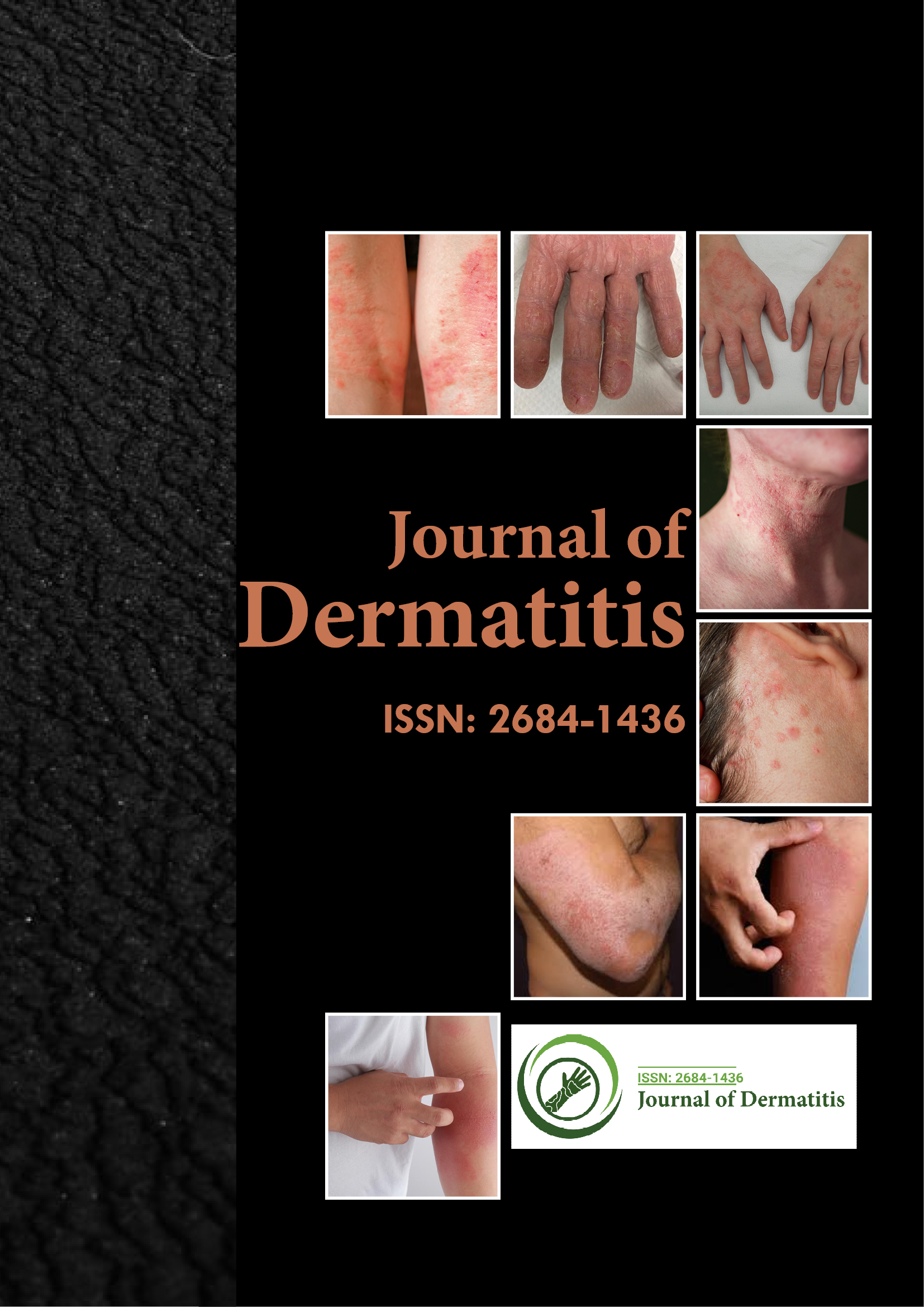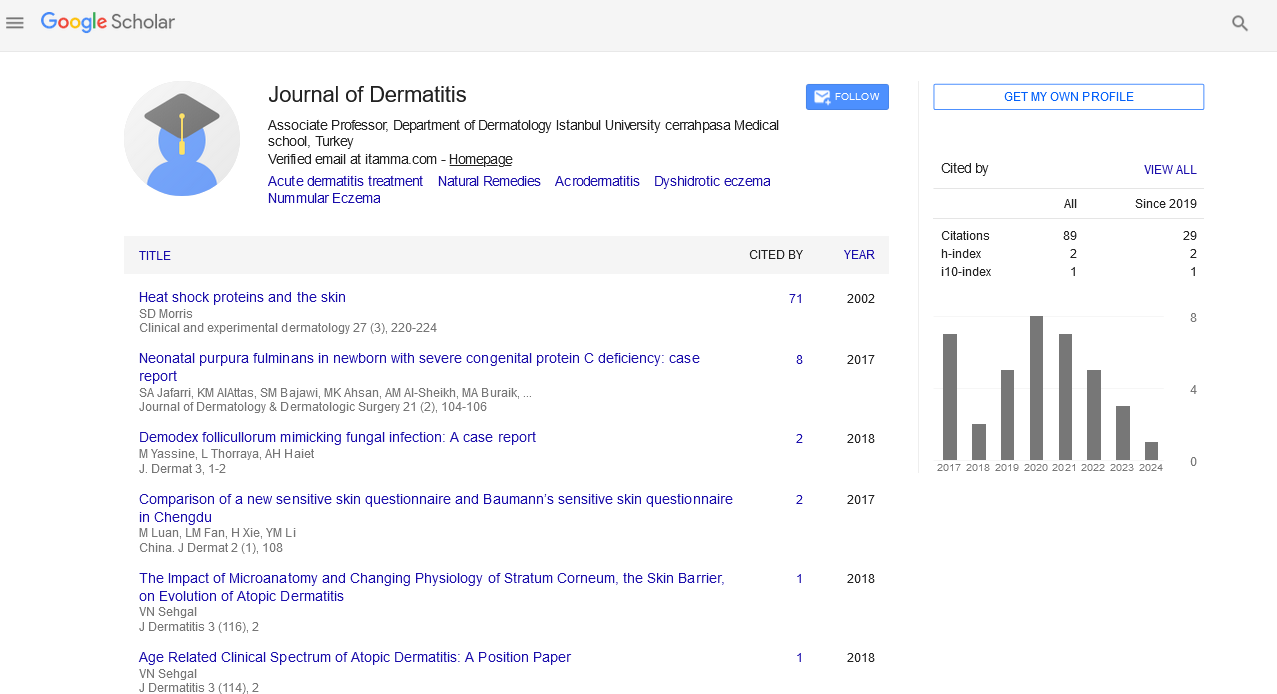Indexed In
- RefSeek
- Hamdard University
- EBSCO A-Z
- Euro Pub
- Google Scholar
Useful Links
Share This Page
Journal Flyer

Open Access Journals
- Agri and Aquaculture
- Biochemistry
- Bioinformatics & Systems Biology
- Business & Management
- Chemistry
- Clinical Sciences
- Engineering
- Food & Nutrition
- General Science
- Genetics & Molecular Biology
- Immunology & Microbiology
- Medical Sciences
- Neuroscience & Psychology
- Nursing & Health Care
- Pharmaceutical Sciences
Opinion Article - (2022) Volume 7, Issue 3
The Pathophysiology, Diagnosis and Treatment of Dermatitis Herpetiformis
David Norito*Received: 03-May-2022, Manuscript No. JOD-22-17069; Editor assigned: 06-May-2022, Pre QC No. JOD-22-17069(PQ); Reviewed: 18-May-2022, QC No. JOD-22-17069; Revised: 24-May-2022, Manuscript No. JOD-22-17069(R); Published: 06-Jun-2022, DOI: 10.35248/2329-6925.22.7.155
About the Study
Dermatitis Herpetiformis (DH) is a chronic, severely itchy bullous skin condition of gluten-sensitive enteropathica commonly known as celiac disease. DH is a skin rash that affects about 10%of people with celiac disease. DH is predominantly found in adults and is common in men and people of Scandinavian descent. DH is rarely found in African Americans and Asian Americans. Dermatitis herpetiformis is characterized by small, clustered papules and vesicles that erupt symmetrically on the elbows, knees, buttocks, back, or scalp. The face and crotch can also be affected. A burning sensation may precede lesion formation. Lesions are usually scraped off when the patient comes to a physical examination and the rash may manifest as erosions or agitation. Enamel deficiency in permanent teeth can also occur in DH patients, another symptom of celiac disease. Less than 20% of DH patients have symptoms of celiac disease.
Pathophysiology
As for pathology, the first signs of illness can be observed in the dermis. Changes that can occur at this level include edema, vasodilation and cell infiltration. Lymphocytes and eosinophil’s are common, the blisters found on the skin affected by dermatitis herpetiformis are sub epidermal and have rounded outer edges. When viewed under a microscope, skin affected by dermatitis herpetiformis shows an accumulation of neutrophils. They have a high prevalence in the area where the dermis is closest to the epidermis.
Diagnosis
A skin biopsy is the first step in diagnosing DH. Direct immunofluorescence of clinically normal skin adjacent to the lesion shows granular IgA deposits in the upper dermis.
Histology of skin lesions may indicate micro abscesses containing neutrophils and eosinophil’s. However, histology can only show excoriation due to the severe itching that the patient experiences. Blood tests for anti-endomysium or anti-tissue transglutaminase antibodies may also show celiac disease. Blood tests for epidermal transglutaminase antibodies are positive in more than 90% of cases, and all of these tests will be negative if you continue on a gluten-free diet for extended periods of time. A -positive biopsy and serology should confirm DH and be considered indirect evidence of damage to the small intestine. A biopsy of the small intestine is usually not needed to diagnose DH. However, if the test reveals clinical signs of gastrointestinal disease, further evaluation may be needed. The DH rash is sensitive to gluten, so you should follow a gluten-free diet with or without bowel damage.
Treatment of herpetic dermatitis gluten-free diet
Dapsone and some other medicines blisters do not go away without treatment. People usually take a gluten-free diet, a diet that does not contain wheat, rye, or barley, which is the main treatment for celiac disease. Oral intake of Dapsone usually relieves within 1-3 days, but Dapsone can cause anemia and requires regular hem cytometers. Sulfa pyridine or sulfasalazine is also taken orally and can be given to people who are intolerant to Dapsone. However, sulfa pyridine can cause anemia and a low white blood cell count increasing the risk of infection and also requires regular blood cell counts.
The disease may be controlled with medication and medication may be discontinued after people have a strict gluten-free diet. However, some people do not stop taking the medicine. For most people, a small re-exposure to gluten causes another relapse. A strict diet without gluten for 5-10 years reduces the risk of intestinal lymphoma.
Citation: Norito D (2022) The Pathophysiology, Diagnosis and Treatment of Dermatitis Herpetiformis. J Dermatitis.7:155.
Copyright: © 2022 Norito D. This is an open access article distributed under the terms of the Creative Commons Attribution License, which permits unrestricted use, distribution, and reproduction in any medium, provided the original author and source are credited.

